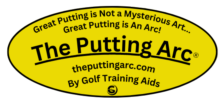 The new MS-3D Putting Arc is a product that has been 12 years in the making. It has evolved from the Original Deluxe model, the newer Deluxe H/D and the very popular MSIII. All of these models will be replaced by the MS-3D, and it will have all of the features of the Deluxe H/D at a lower price, as well as the advantages of the MSIII (lighter weight, waterproof, durability, and travel-ability). The new MS-3Ds will be produced in the original flat black color of the first MSIIIs. This color creates much less glare in the sunlight. Many of these very first MSIIIs are still seen on the PGA Tour practice greens, even though the black MSIII has not been made for seven years.
The new MS-3D Putting Arc is a product that has been 12 years in the making. It has evolved from the Original Deluxe model, the newer Deluxe H/D and the very popular MSIII. All of these models will be replaced by the MS-3D, and it will have all of the features of the Deluxe H/D at a lower price, as well as the advantages of the MSIII (lighter weight, waterproof, durability, and travel-ability). The new MS-3Ds will be produced in the original flat black color of the first MSIIIs. This color creates much less glare in the sunlight. Many of these very first MSIIIs are still seen on the PGA Tour practice greens, even though the black MSIII has not been made for seven years.
The new MS-3D will also have a feature requested by many of the top instructors who have given ustheir feedback. This feature is the fully adjustable, high quality, impact resistant mirror that will work for the original heel arc as well as the newer toe arc. It can easily be adjusted to check eye alignment, shoulder alignment, and head movement during the putting stroke. Now, for the first time, all of these important putting basics can be checked while making the pure, on-plane putting stroke used by a majority of the top touring pros.
The original Deluxe Putting Arc was first introduced in 2002, and it was patented by PGA Instructor VJ Trolio and Engineers Joey Hamilton and Dave Hamilton. The Deluxe was soon followed by the small, portable T3, the popular mid-size MSIII, and finally by the Deluxe H/D, with the heel/toe capability. The original Deluxe and the H/D are both beautiful pieces of Mississippi Show Wood. In 2003 there were many show wood producers in the high volume furniture manufacturing areas of North Mississippi. Now there are no show wood companies, and the materials and people to produce this product are scarce and expensive. It has finally become too difficult to make the wooden product at an affordable price, and the new MS-3D will ensure that the Putting Arc is still available to the junior, high school, college, professional, or the serious amateur golfer.
The new MS-3D was created to take the place of the Deluxe and the MSIII. It has the same usable surface area as the others, it is lighter and more durable than the Deluxe, and it has the extra advantage of the mirror. This new product will not make any of the existing Putting Arcs obsolete; rather it will make them more useful. VJ’s “Bridge Drill” is the best practice drill for the Putting Arc stroke, since it is a non-contact drill with immediate feedback when the stroke is off. This drill uses the new MS-3D along with any of the original Putting Arcs (T3, Deluxe, H/D or MSIII). The existing DVD and the new literature will fully explain how to do this drill.
The name MS-3D is a perfect fit for two reasons.
First, the actual surface of the Putting Arc is a three dimensional representation of the putter heel or toe path as it travels back and forth on an inclined plane. This plane was determined by the formula found on the top of every Putting Arc, and we have found that golfers of all sizes have had success with the design measurements used to shape the Putting Arc.
The vertical surface of the Putting Arc is the vertical extrusion of the putter path on this inclined plane, projected onto the ground. The formula for this arc was first developed by Apollonius of Perga some 2200 years ago, and this math still works today, as evidenced by the more than 1200 professional wins since 2003 and the nine professional major wins by known users in 2013.
Also, the PGA Tour all-time scoring record was set by a golfer who used the Original Deluxe Putting Arc for only two weeks, then made every putt within seven feet, and 58 of 60 putts inside ten feet, to set a record that still stands today.
Second, this new name also reflects the addition of the toe arc and the mirror to the original heel arc, so the MS-3D works on three different levels. The toe arc and the mirror allow the golfer to balance his or her stroke and not build any kind of radial force into the putting stroke, and to learn and constantly monitor eye and shoulder position and head stability.

